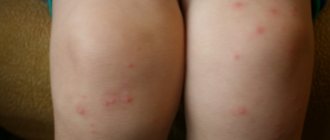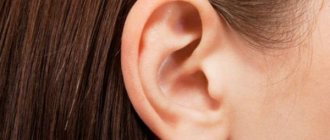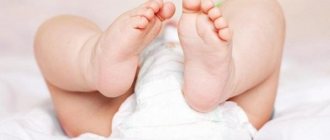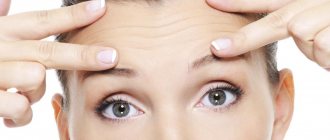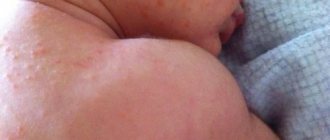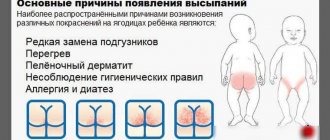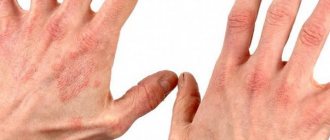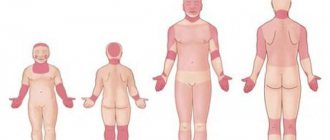Dermatitis on the butt of a child
The most common location of skin ailments is the buttocks.
Dermatitis on a child’s bottom (photo 5) manifests itself for a variety of reasons: a reaction to powder, overheating. No matter how dermatitis manifests itself in children, most symptoms are common: itching, increased sensitivity, burning. Any irritation on the child’s buttocks may mean that a diaper type of disease is developing. Often, dermatitis on a child’s bottom is a good basis for the proliferation of additional infections. If it repeats too often, you need to contact a specialist.
Diaper dermatitis in children
Dermatitis from diapers affects the area of the buttocks and genitals, where the diaper comes into contact with the skin. The main symptom of the disease is severe inflammation. Diaper dermatitis (photo 6) can cause small wounds to appear.
The wrong diaper size causes contact dermatitis in babies, where the skin suffers injury caused by friction. A child diagnosed with diaper dermatitis constantly shows anxiety and often cries. In addition, he tries by any means to get rid of the diaper.
What does diaper dermatitis look like in newborns?
As a result of improper care, diaper dermatitis occurs in newborns (photo 7). Bright red spots have irregular edges. Further development of the disease leads to peeling, weeping, and the appearance of pustules.
The disease in newborns is provoked by wet diapers, lack of skin breathing, infrequent washing of diapers, and irregular hygiene procedures. Treatment of diaper dermatitis in children should be carried out immediately, without waiting for the appearance of pustules, gray crusts and ulcers, which will harm health.
Treatment of diaper dermatitis
The fight against this type of dermatitis does not have to be carried out in a hospital setting. Treatment of diaper dermatitis in children at home is an important issue. Some important points should be observed:
- after emptying, the diaper is removed immediately;
- the child is washed away;
- You can only use special soap;
- the skin is gently blotted;
- apply a special cream.
Treatment of diaper dermatitis involves taking air baths. This is one of the prerequisites for the skin to naturally dry, breathe, and rest. To get rid of the disease, treatment is carried out with ointments with zinc oxide. Ointments are used as astringents, protective, antiseptic, against fungi - different types of dermatitis require the use of a specific product. Treatment of dermatitis complicated by infection is carried out with corticosteroids prescribed by the pediatrician.
Causes of perianal dermatitis
The inflammatory process, due to the pathogenic activity of microflora, contributes to the occurrence of perianal dermatitis.
Reasons that may contribute to the development of the disease:
- Haemorrhoids.
- Helminthic infestations.
- Stool disorders - diarrhea.
- Insufficient hygiene.
- Tumors of the colon and/or rectum.
- Diseases of the digestive system.
- Disturbance of intestinal microflora.
- Underwear is the wrong size (narrow or tight).
- Clothes made from synthetic fabrics.
- Allergic reactions to detergents or cleaning products.
- Injuries to intimate areas.
- Fungal or infectious infestations.
- Enterobiasis.
In children, anal dermatitis occurs for the same reasons as diaper dermatitis - prolonged exposure to a diaper, irritation or wounds in the anal area.
People prone to allergies, as well as patients with low immunity levels, are at risk. In older people, there is a decrease in the barrier functions of the skin, as a result of which the penetration of infections leads to the development of this disease.
Find out more
Methods for getting rid of skin disease
At the first stage of development of the disease, treatment is limited to taking measures at home. If we are talking about newborns, it is enough to reconsider the quality of nutrition. A nursing mother is not recommended to consume allergenic foods. For artificial nutrition, clarify the composition of baby food, taking into account the nature of the baby’s body’s susceptibility. If necessary, mild antihistamines are indicated: from birth to 6 months - Fenistil drops and gel; from six months - Zyrtec drops.
Treatment of allergic diathesis in children occurs in different ways: in some it disappears on its own after a certain period of time; in others it progresses and can even cause asthma.
The level of severity of the disease is determined by the effectiveness of the measures taken. If after a course of therapy the result is zero, the baby and mother are hospitalized.
In the serious condition of a small patient, when the disease is advanced and does not stop progressing, the doctor prescribes glucocorticoids. When infected with infections, the patient receives antibiotics. For general support of the body, complexes of drugs containing useful minerals and vitamins are recommended.
To relieve pain, eliminate burning and itching, children are prescribed:
- Erius.
- Cetrin.
- Zodak.
- Cetrin.
These drugs do not cause increased drowsiness and are impossible to get used to.
In case of infection with streptococci or staphylococci, the following medications are used:
- Fucoseptol.
- Chlorhexidine.
- Fukortsin.
- Miramistin.
An allergist sometimes prescribes immunomodulators to help a baby cope with the advanced stage of the disease. It is permissible to use drugs of this effect only with the permission of a doctor, who will take into account contraindications. For example, their use is not allowed in case of autoimmune problems, otherwise negative consequences cannot be avoided, because such drugs are introduced into the immune system.
External preparations are recommended to be applied 1-2 times a day:
- Non-hormonal ointments will help get rid of mild symptoms: Radevit, Fenistil, Keratolan.
- If the pathology is widespread, you will have to resort to hormone-based products: Akriderm, Sinaflan.
- Lokoid, Advantan, Afloderm can reduce the activity of an allergic reaction.
- For rapid regeneration of affected skin areas and wound healing, the following are used: Actovegin, Dexpanthenol, Bepanten.
Physiotherapeutic procedures help not only to consolidate the results, but also normalize the general condition of the body, weakened by the disease:
- Therapy using laser irradiation.
- Electrosleep.
- PUVA.
- Therapeutic baths.
- Reflexology.
- Treatment with mud.
- Ultraviolet exposure.
Types of rash
Depending on what exactly triggered the appearance of the rash, all inflammations can be divided into several categories. Some of these categories are specific to allergic reactions, and some to inflammation. Of course, in order to understand what exactly triggered the appearance of the rash, it is necessary to analyze what changes have taken place recently. Perhaps a new item has appeared in your wardrobe, or you recently stood at a bus stop for a long time and got cold?
If you can’t find the cause on your own, the only thing left is to look carefully at what the rash looks like. This will further help determine what kind of disease we are talking about.
- Spots are the most common type of rash. Their color changes depending on what disease has affected the body. Most often, spots on the buttocks are red.
- Watery blisters - they have a fairly rough texture and protrude above the surface of the skin.
- Blisters - some people tend to confuse them with blisters, since the blisters also contain liquid inside. It has a cloudy color.
- Acne is a formation that is filled with pus inside. In most cases, such rashes appear in people who have liver problems.
- Scales - they are a secondary element of the skin. Such manifestations are mostly associated with an allergy to any product.
After reading this, you involuntarily begin to think about how different rashes can be. But many people mistakenly believe that it has only a certain appearance that cannot change. Of course, this is not true. And partly thanks to the presence of varieties of rashes, doctors are able to quickly make a diagnosis and prescribe the correct treatment.
Allergic manifestations on the buttocks in the form of red spots
Watery blisters on the skin of an adult
How and with what to treat baby diaper dermatitis
Knowing why diaper dermatitis occurs in children, parents can prevent its occurrence. To do this, it is enough to avoid prolonged skin contact with wet, dirty diapers, as well as to choose and put on the right diaper.
Buy diapers for children that fit them in size, do not skimp. In no case should it squeeze or rub anywhere, because friction greatly increases the manifestations of diaper dermatitis.
Therefore, when putting a diaper on a child, always pay attention to ensure that its edges do not wrinkle or curl, straighten the Velcro and make sure that the elastic bands do not pinch too much
A full and dirty diaper should be removed immediately, even if you have only recently put it on. Read how often diapers should be changed. Of course, the baby’s butt and perineum should be washed with warm water every time. At the same time, always make sure that after water procedures the child’s body remains dry - do not put a diaper on wet or not dry skin. You never need to rub it - just blot it with a towel or diaper that absorbs moisture well.
When changing your baby's clothes, allow him to be naked for a while - the more, the better.
Such simple regular procedures will prevent the development of diaper dermatitis in a newborn. But if the problem has already arisen, then, of course, parents are interested in the question of how to cure diaper dermatitis at home.
Diaper dermatitis in a baby: what to do at home?
If you start acting as soon as redness or flaking of the skin under the diaper appears, then diaper dermatitis can be cured within 1-2 days. And the main assistant in this will be air. Nothing treats this skin inflammation better than air, which means it is necessary to provide as long as possible air baths for sore baby bottoms. Undress your baby as often as possible and leave him naked for as long as possible!
Proper hygienic care, as mentioned above, is especially important. You may have to wash your baby more often than usual, but under no circumstances with hot water - only with warm water. During the treatment of dermatitis, refuse any children's cosmetics (except those that are suitable for this case). If you see that the diapers you are using are not suitable for the child (just like soap, napkins, cream, powder, washing powder), then they need to be replaced with better ones.
But it is not always advisable to smear the skin with diaper dermatitis. Moreover, if you are going to smear it, you definitely need to know what exactly.
How to treat diaper dermatitis in children
If the skin is simply red under the diaper, then air baths will quickly cure such dermatitis. You won't even need any additional procedures. However, severely flaky or weeping skin must be treated with special products.
The algorithm of actions here should be obvious: dry skin must be moisturized, if it becomes wet, it must be dried. Ointments, creams, powders, oils and other products must be chosen based on this.
In each individual case, one or another drug may be effective. Reviews indicate that Bepanten, Desitin, Dropolen, Zinc ointment have proven themselves well - the main thing is to choose a product with the effect required in your case. But it is better not to use hormonal ointments for the treatment of diaper dermatitis, because children's skin has very good absorption properties and will intensively absorb such an ointment, which may have negative consequences in the future.
Mothers also recommend traditional medicine recipes for diaper dermatitis:
- Give your child baths with potassium permanganate, string, chamomile, horsetail, calendula, mint and other herbal decoctions.
- Brew 2 tablespoons of oats with a glass of boiling water, let it brew for 30 minutes, then strain and add the infusion to the water when bathing the child.
- If your baby is bothered by itching, you should grind 1 cup of oats into flour, pour a liter of boiling water over it, boil for 20 minutes and add to the bathing water.
- Pour two glasses of rolled oats into cheesecloth and tie them in a bag. Place it in a suitable container, pour boiling water over it and leave for 2 hours. Then the now clean, bathed baby should be placed in a bath with clean water and Hercules infusion poured into it. At the same time, you need to rinse the bag of cereal, “washing” the contents out of it. Let the baby take such baths every day. Hercules envelops the skin with a thin film that protects and very gently cleanses it.
- Prepare a paste from the root or stalks of celery and potatoes, using equal quantities of each. Apply the mixture to the affected areas of the skin and leave for 10 minutes.
Causes
A number of factors can contribute to the development of inflammation in the buttocks. At the same time, the basis of any dermatitis is the hypersensitivity of the immune system, leading to local dilation of the microvasculature, followed by the formation of edema and irritation of sensitive receptors.
Gluteal dermatitis in adults can be caused by:
- Allergic reactions of the atopic type. They are a component of atopic dermatitis, which can affect any area of the skin;
- Individual hypersensitivity to the composition of underwear or bed linen, personal hygiene products;
- Skin irritation in bedridden patients due to constant skin contact with urine or feces;
- Development of bacterial or fungal skin lesions;
- Constant increased humidity, which is especially often observed between the buttocks and in the femoral-gluteal fold.
Treatment methods for diaper dermatitis
Treatment methods for diaper dermatitis in newborns and children of the first year of life are divided into medicinal and therapeutic:
- Therapeutic methods include the prevention of diaper dermatitis, hygiene and proper care of the baby's skin under the diaper, including regular air baths.
- Drug treatment is prescribed by the attending physician after diagnosing the disease, as well as when a secondary infection has occurred or the child has a weak immune response to the ongoing disease.
Medications
The most important factors when choosing a drug for the treatment of diaper dermatitis with secondary infections is the identification of their causative agent, usually Candida fungi, staphylococcal and streptococcal infections.
Based on the diagnosis, the pediatrician prescribes antimicrobial or antifungal drugs along with ointments for the speedy regeneration of the damaged epidermis. In addition, in order to reduce itching and swelling of the skin, the pediatrician may prescribe antihistamines.
| Purpose of the drug | Name, release form | price, rub. | Application | Course duration, days |
| Antifungal drugs | Nystatin, ointment | from 49 rub. | Apply to affected areas 1 - 2 times. /d. | 7 — 14 |
| Clotrimazole 1%, cream | from 57 rub. | 10 -14 | ||
| Pimafucin 1%, cream | from 187 rub. | 7 — 11 | ||
| Sertamicol 2%, cream | from 402 rub. | 5 — 7 | ||
| Antimicrobials | Mupirocin 2% (supirocin), ointment | from 562 rub. | Apply to affected areas 2 - 3 times. /d. | 10 |
| Fusidic acid 2% (fusiderm), cream | from 327 rub. | 7 — 10 | ||
| Antihistamines | Finistil, drops | from 327 rub. | The daily dosage is calculated by the pediatrician taking into account the child’s weight. The daily dosage is divided into 3 doses. Taken as prescribed by a doctor under his supervision. | |
| Zyrtec, drops | from 220 rub. | |||
| Zodak, drops | from 199 rub. | |||
| Wound healing, anti-inflammatory, emollient drugs | D-Patnenol, ointment | from 168 rub. | Apply after each diaper change, linen change or water procedure to the affected areas of the skin. | Daily |
| Bepanten, ointment | from 438 rub. | |||
| Drapolene, cream | from 293 rub. |
Traditional methods
Traditional methods are advisable to use for minor redness, at the initial stage of diaper dermatitis or as a preventive measure.
To do this, decoctions of string, chamomile flowers, which have an anti-inflammatory effect, or oak bark, which contains tannins that dry out the skin, are added to the bath.
Bathing your baby in medicinal herbs will help prevent diaper rash
To prepare the infusion, you need to take 2 tbsp. l. dry raw materials (grass, flowers, bark), pour 1 tbsp. boiling water and leave for 30 seconds. Then strain and add the broth to the bathtub.
Other methods
During an acute illness with complications, it is not recommended to wash a child with hygiene products containing alkalis (they dry out the skin), or to use wet wipes, especially those containing alcohol. These remedies will not reduce inflammation and irritation, but will only cause pain to the baby.
To treat affected areas after urination or defecation, doctors recommend using a weak pinkish solution of potassium permanganate (potassium permanganate) or a pharmaceutical solution of furatsilin.
A weak (!) solution of potassium permanganate is used to treat damaged baby skin
Preparation of potassium permanganate solution:
powder (2 - 3 grains) is diluted in 50 ml of warm water in a separate container; after the grains are completely dissolved, 2/3 of the concentrate is carefully poured into the bathing container until a faint pink tint is obtained, it is important to ensure that undissolved grains do not get into the child’s water, this can cause a serious chemical burn; the remainder of the concentrate is disposed of.
How to treat
Treatment of dermatitis on the buttocks is determined depending on the form of the disease and the degree of skin damage. An integrated approach is used: medications, diet therapy, alternative medicine methods.
A properly selected diet will help to significantly reduce the load on the digestive organs and organs of the urinary system, which, in turn, will help to quickly get rid of dermatitis!
Methods of first aid for dermatitis include:
- Special hygiene rules. It is necessary to use hypoallergenic hygiene products that do not irritate the skin (baby soap, gels). After washing, the skin must be moisturized; the manifestations of dermatitis intensify when it is dry. It is best to use baby creams.
- Wearing loose underwear made from natural fabrics. This approach will protect against allergies, allow the skin of the buttocks to “breathe”, and relieve it from excessive friction.
- Nutrition correction. At the first manifestations of dermatitis on the buttocks, you need to avoid fatty, smoked, spicy, salty and sweet foods.
- Maintaining a stable psycho-emotional background. There is no need to panic or be nervous: a negative emotional state only contributes to the progression of the disease. To calm down, you can use meditative and breathing techniques, light herbal teas.
Medicines from the pharmacy
To treat dermatitis on the buttocks, a number of medications are used for internal and topical use.
- Antihistamines are prescribed as first aid for dermatitis. The drugs quickly relieve itching, burning, and swelling. Among the most effective remedies with a minimum of side effects: Claritin, Cetrin, Zyrtec.
- If antihistamines are ineffective, external agents containing hormones (Akriderm, Sinaflan, Diprosalik ointments) are prescribed.
- To relieve nervousness, which often accompanies gluteal dermatitis, it is optimal to use sedatives without a strong hypnotic effect: Glycine, Novo-Passit.
- In case of weeping, purulent or ulcerative rashes on the buttocks, compresses with antiseptics (Chlorhexidine, Zinc ointment) are used.
Folk remedies
Alternative treatment for dermatitis on the butt in an adult can offer a lot of effective and simple recipes. Their use effectively complements conservative therapy.
Herbal remedies have a calming, disinfecting, restorative effect. Their use relieves inflammation, itching, and swelling.
Among the simplest recipes:
- Chamomile. 4 tbsp. dried flowers of the plant need to be filled with 2 liters of water. The liquid is simmered over low heat for 15 minutes. Then strain and add to the pre-filled bath water.
- Oak bark. The crushed bark (1 tbsp) is poured with 1 glass of water and simmered over low heat for about 20 minutes. The infusion is filtered and added to the bath.
- The use of ointments and tinctures based on beeswax. The product disinfects tissues, restoring the affected areas. The product is placed in a metal container, where a little water is added, and heated to 40°C. The resulting natural ointment is applied to the inflamed skin of the buttocks. For greater effect, you need to chew beeswax once a week.
- Propolis. The product must be crushed and mixed with vegetable oil (1:4). Place the product in the oven, where it is heated at minimum temperature for 45 minutes.
Diet
Diet therapy is an important component of the treatment of dermatitis on the buttocks in adults and children. A specially developed diet will speed up recovery time, regardless of the form of the disease and the degree of damage.
Symptoms and signs
Despite the limited exposure - the child touched something with his hands that could cause an inadequate reaction, inhaled allergens with vapors from household chemicals or mother's perfume, general sensitization develops. At the same time, it can be quite difficult to establish what and when went wrong. With allergic dermatitis, as mentioned above, the reaction is delayed, which means that it can appear only a few days after contact with the allergen. At the same time, you still need to be able to remember what the child touched, where he was, what he breathed and what he ate. It is in principle impossible to answer all these questions with great accuracy.
With allergic dermatitis, the main symptom is a rash. In general, the skin is quite tense, especially at the site of contact with the allergen, if we are talking about the contact form. The affected area appears red and slightly swollen. In the non-contact form, the rash can appear on the most delicate parts of the body - on the face, especially on the cheeks, on the scalp in the hairline, as well as on the arms and legs, especially in the skin folds at the folds.
The rash may look like small pink dots, and quite often bubbles appear that quickly burst, leaving a weeping, gradually drying crust. All elements of the rash appear simultaneously; they do not have clear boundaries.
An older child will be able to clearly complain about itching. For up to a year, a baby will constantly reach out with his hands to the affected areas and try to scratch them. A newborn baby will behave restlessly, since severe itching can disrupt his sleep and appetite. With severe allergic dermatitis and a large affected area, the child’s temperature may rise to subfebrile levels - 37.5 0 37.9 degrees.
What it is?
If the appearance of perianal dermatitis in children is usually associated with a violation of child hygiene standards, then an “adult” disease usually occurs against the background of pathologies of the large intestine and rectum. These could be diseases of the anal area, a violation of the intestinal microflora, an allergic reaction of the body, etc.
Based on the causes of occurrence and characteristic signs, a classification of types of perianal dermatitis has been compiled:
- Allergic form - accompanied by redness of the skin around the anus, a rash of translucent pimples filled with liquid. Often, the manifestation of the allergic form disappears after limiting or completely stopping contact with the allergen.
- The bacterial form is caused by severe itching and pain, coupled with rashes of translucent sores filled with dull green pus. The rashes strongly resemble the herpes virus, since after the integrity of the sores is damaged, dark, crusty ulcers form in their place.
- Fungal form - has clear boundaries of the source of inflammation. This form is characterized by hyperemia (oversaturation of a particular organ with blood) and peeling of the skin. After a while, the redness becomes covered with a whitish film and rash.
- “ Jeep disease ” is the extreme, most severe form of the disease, which is also characterized by purulent rashes. However, over time, acne does not go away, but turns into deep ulcers that cause severe pain. “Jeep disease” is also characterized by a high incidence of complications in the absence of timely treatment.
In order to recognize perianal dermatitis, you need to know the symptoms characteristic of this disease:
- Itching and burning in the anal area. When scratching the inflammation, patients usually complain of severe pain.
- As a result of irritation, the skin becomes swollen and red.
- Rashes appear around the anus. Their nature and severity depend on the form of the disease. Over time, the infected areas of the skin become covered with a crust.
Symptoms and locations
Despite the wide variety of clinical features, it is possible to identify common features of the course of eczema in most children.
During the inflammatory reaction, blisters form in groups on the child’s skin. In an acute process, against the background of extensive redness of the skin and swelling, papular rashes appear, very quickly turning into blisters.
The blisters open, forming a wound surface on which a bacterial or viral infection quickly develops. After the weeping process decreases, crusts form. The child is bothered by itching.
Initially, foci of the rash may appear on the cheek, near-oral area, gradually moving to other areas of the face. As the process spreads, the lesions increase in size and become symmetrical.
In appearance, eczema is similar to the manifestation of other skin pathologies. Signs of eczema in children:
- redness of the skin (especially pronounced on the cheeks);
- rashes on the child’s face, arms or legs;
- intense itching, peeling;
- the formation of nodules and blisters, which subsequently disappear, forming erosive lesions and crusts.
The main affected areas are the face (cheeks), arms (palms and elbows) and legs. Eczema appears in children and on the butt. When its symptoms appear, it is necessary to use an ointment or cream to alleviate the condition. In the photo below you can see what the disease looks like at different stages.
The common features that unite them are:
- The presence of foci of inflammation, the appearance of red spots without clear boundaries and vesicles filled with serous fluid;
- Papular rash;
- Constant itching:
- Peeling of the skin;
- Erosive formations - weeping wounds.
A distinctive feature of the bacterial course of the disease is the presence of an initial focus at the site of injured skin - from a scratch, burn or abrasion. The lesion appears in the form of an oval shape with clear edges. Gradual progress leads to the formation of a wet surface. This kind of eczema occurs on the legs of a child - activity and mobility provoke the appearance of minor injuries.
The rash characteristic of eczema appears in children mainly on:
- scalp;
- face;
- palms, inner sides of the arms;
- feet, knees, legs;
- back;
- groin area, buttocks.
The initial stage develops on the arms, legs, and face of newborns. Without treatment, the rash spreads over large areas. When a child scratches the affected areas, a secondary infection may occur. The photo shows viral eczema in a baby on the legs and butt.
Some time after the appearance, eczema spots enlarge, merge and form a large area of the lesion. The skin thickens and becomes rough. The bubbles that appear with colorless contents gradually open, forming pockets of erosion. Inflammation may be accompanied by swelling.
The child's general condition worsens. The following symptoms appear:
- increased body temperature;
- loss of appetite;
- worsening sleep;
- moodiness;
- nausea.
The chronic form is fraught with periodic exacerbations. They can be caused by an allergic reaction, lack of vitamins, or stress. Periods of remission can be long.
Eczema in children develops in several stages. The following stages of damage are distinguished:
- redness, slight swelling, itching (erythematous);
- formation of nodules (papular);
- development of nodules into blisters with serous fluid (vesicular);
- opening of bubbles with the release of exudate (wetting);
- the appearance of crusts on the affected area (crusted);
- skin renewal with exfoliation (final squamous).
Eczema in children can be weeping, dry, or microbial. In the dry form, the skin pattern becomes expressive, the skin becomes rough and cracks. Weeping eczema is not infectious. Transparent or translucent serous exudate is released after the vesicles are opened. A crust forms in their place. The microbial form is considered a secondary disease that occurs against the background of allergic or infectious processes.
| Form | Description |
| True | Presence of all characteristic symptoms |
| Viral | Occurs due to viral infections |
| Seborrheic | Appears on the scalp with transition to the face due to improper treatment of seborrhea |
| Bacterial | Entering the body of a corresponding infection |
| Mycotic | Primary damage by fungal infections |
| Atopic | Consequence of an allergic reaction |
How to cure gluteal dermatitis
Dermatitis is an inflammatory lesion of the skin that causes a person discomfort and a lot of unpleasant sensations. Especially if it is dermatitis on the butt. The disease begins due to the influence of negative internal and external factors. They irritate the skin and lead to damage and rashes. An integrated approach to the treatment of dermatitis will speed up the healing process, and compliance with preventive measures, proper nutrition, and skin care will restore its integrity and health.
Recommendations for mom
To cope with this disease, you need to follow certain rules:
Use emollients - these products prevent moisture loss. The baby's skin should be well moisturized. Therefore, emollients should be part of daily care.
Emollients should be odorless. It should be borne in mind that ointment or cream moisturizes the skin much more effectively than lotion. After the bath, the skin should be carefully blotted with a towel, and then an emollient should be applied. Do not allow the baby's skin to come into contact with irritating substances and tissues. If your baby is highly sensitive, it is recommended to choose clothes made from natural materials - for example, cotton.
You should not use fabric softener often. It is recommended to limit the baby’s time in the shower or bath to 5-10 minutes.
It is important that the water is at room temperature. Swimming in hot water is not recommended
In addition, the risk of infection increases significantly. You need to monitor the condition of your baby’s nails - they should be short enough and not have sharp edges.
Dermatitis often results from allergies to food, wool, and dust mites. If this connection is proven, contact with the allergen should be avoided. Exacerbation of dermatitis may be a consequence of overheating or severe stress.
In such a situation, it is very important to avoid provoking factors. Various types of dermatitis are quite common in children
Various types of dermatitis are quite common in children.
Komarovsky claims that serious lifestyle adjustments will help you forget about the disease, which includes changing your approach to nutrition, choosing high-quality clothes and toys, and monitoring air parameters.
Thank you very much, Doctor, for the article! My son (breastfed) started having blood pressure at 3 weeks, I had never heard anything about him before. My daughter had nothing like this when she was a child. I called a doctor, she prescribed Fenistil drops and a diet (you can eat everything as for nursing mothers, but only natural from the village). I started following the doctor’s advice, my blood pressure did not go away, then we were told that we needed to take 4 drops of vitamin D. And then it all started, it started to pour out so much that I didn’t eat anything anymore, just water and oatmeal. Then I went online and accidentally found your article, started doing everything as you wrote, and most importantly, I stopped vitamin D from 4 drops to 1 drop, added calcium (Calcium complex), humidified and ventilated the room, switched from breastfeeding on demand to hourly , added some water. Everything has passed, we are already 5.5 months old, I am breastfeeding, eating milk, cottage cheese, kefir, fruit juice. there is no allergy to fish, eggs, and he probably didn’t have any, he just overfed him, 1st month - weight gain 1.5 kg, 2nd month - 1.2 kg, 3rd month - 0.9 kg. I will be introducing complementary foods soon. Thank you Doctor for the article, good health and long life to you! .
Hello, dear readers! Take a closer look at your baby. And if he has redness, especially in the folds of the skin, or a rash, be sure to tell your pediatrician about them, since in fact they may indicate the presence of a dangerous disease.
Its name is atopic dermatitis in children. Treatment, Komarovsky argues, in this case should begin immediately. Otherwise, a seemingly banal childhood illness can spread into adulthood, causing a lot of discomfort both to the child and his parents.
Prevention
To avoid relapse of the disease, parents should pay special attention to preventive measures.
In the contact form, this primarily concerns the child’s hygiene.
Linen and diapers should be changed in a timely manner. Since children, even in infancy, are very active, they sweat actively.
Therefore, you should wipe your baby’s body with napkins as often as possible, especially in intimate places.
All cosmetics that a mother uses to care for her child must be hypoallergenic.
To wash children's clothes, especially underwear, you should use only laundry soap, as it does not contain fragrances or dyes.
As for allergic and atopic types, parents need to carefully monitor the baby’s diet and not start premature complementary feeding with foods that are considered strong allergens.
If the child is breastfed, then the mother should approach her diet with particular seriousness and exclude foods that provoke an allergic reaction in the child.
Diagnosis of diaper dermatitis
If the child’s parents or staff suspect that the baby has diaper dermatitis, then there is no delay in making a diagnosis.
If the doctor suspects the addition of a secondary infection, then additional tests are necessary:
- General blood analysis. Taking capillary blood from a finger to determine the general condition of the child and his ability to resist infections, as well as identifying the inflammatory process.
- Bacteriological seeding of material from injured areas of the skin to identify the causative agent of infection. Laboratory assistants remove particles of the epidermis from the most affected areas and place them in a nutrient medium to identify pathogenic organisms. Tank seeding makes it possible to accurately identify the pathogen and select antibiotics to suppress or destroy it.
- Stool analysis to determine pH and exclude dysbacteriosis.
All 3 analyzes are considered in combination; each individually cannot give a complete picture of the course of the child’s illness. The collection of material and its analysis can be carried out in a children's clinic.
General symptoms
All types of dermatitis have certain common signs that allow one to suspect just such a skin disease:
- inflammation of the skin area, redness, swelling;
- itching and burning sensation in the affected area;
- the appearance of blisters, blisters;
- a fairly rapid transition from the initial stage to the cortical stage.
How long does it take to treat diaper dermatitis?
If in order to eliminate individual manifestations of diaper dermatitis, it is enough to regularly give the child air baths, then the advanced disease requires drug treatment, including antibiotics. Most often, for diaper dermatitis, the doctor prescribes the following medications.
We suggest you familiarize yourself with the difference between seborrhea and psoriasis - the main symptoms. How is seborrhea different from psoriasis?
Table. Medicines for diaper dermatitis.
You need to bathe your child daily; the procedure lasts 15-20 minutes. Each time, herbal infusions are added to the water. The series is especially effective for treating children with diaper dermatitis.
Bathing with diaper dermatitis
After water procedures, dry the child's skin with blotting movements. If there are dry areas on the skin, treat with a special cream or baby oil. In case of weeping skin, dry it with children's medicinal cosmetics.
Possible complications of dermatitis
Candidiasis diaper dermatitis does not respond to traditional treatment; relapses of the disease are often observed when the child’s immunity is weakened. All complications are accompanied by a deterioration in the baby’s well-being. The temperature rises, appetite disappears. The baby often whines and sleeps restlessly. The listed facts indicate the necessary seriousness and consistency of treatment for diaper dermatitis.
Diaper dermatitis in infants is observed in the buttocks and inner thighs. Several factors influence its appearance:
- mechanical irritants - fabric or diaper rubs against the baby’s delicate skin;
- chemical effects - negative effects of ammonia, stool enzymes and fatty acid salts;
- physical factors - excessive sweating, humidity and temperature affect the appearance of diaper rash;
- microflora disturbance - E. coli and other pathogenic and opportunistic microorganisms.
Diaper dermatitis in newborns most often occurs due to violations of general hygiene rules. The use of inappropriate gauze diapers and diapers, or untimely changing of a wet or dirty diaper increases the risk of diaper rash.
There are a number of childhood diseases that dramatically increase the likelihood of developing diaper dermatitis - allergies, atopic eczema, impaired water-salt metabolism, unstable stools, increased ammonia in the urine, immunodeficiency.
According to some data, diaper dermatitis affects from 30 to 50% of infants; the disease is most common among girls. The inflammation can be localized with a small area of damage in the form of redness on the skin; more severe cases of diaper dermatitis with deep damage to the skin also occur.
Diaper dermatitis in boys (photo below) is less common than in girls. This is due to the peculiarity of the structure of the genitals. Artificial feeding often causes allergic dermatitis in children, which can cause redness and swelling all over the body.
The disease can occur in the first week of life. Diaper dermatitis in children (photo 3) is caused by under-dried diapers, poorly rinsed or washed with inappropriate powders. Simultaneous exposure to feces and urine plays a huge role in the development of the disease. Against the background of diaper rash, atopic dermatitis may also appear in children if there is a hereditary predisposition.
If areas of bright red color with pustules appear on the child’s body, then candidiasis diaper dermatitis has begun (photo 4). Most often, the manifestation of this type of disease occurs in the first year. Candidal dermatitis has its own characteristic signs:
- natural folds become covered with miliaria;
- urination when the perineum is affected causes crying;
- manifestation of blisters, cheesy coating.
Reasons for appearance
Almost any disease occurs due to a number of unfavorable factors affecting the body. The causes of perianal dermatitis include :
- Infectious intestinal diseases accompanied by prolonged diarrhea.
- Passive lifestyle.
- Excess weight.
- Excessive passion for cycling.
- Inappropriate underwear (synthetic, too tight).
- Violation of the rules of hygienic care of the skin around the anus.
- Anal fissures.
- Haemorrhoids.
- The presence of diseases that have a parasitic basis.
- Chronic bowel diseases.
- Mechanical damage to the skin.
- Weakening of the immune system.
- Poor quality washing of underwear, etc.
Experts identify risk groups that are most often susceptible to developing the disease. So, the following stand out separately:
- representatives of non-traditional sexual orientation;
- HIV-infected;
- elderly;
- people who neglect personal hygiene.
People who take certain medications (for example, antibacterials) for a long time are susceptible to the development of perianal dermatitis.
Atopic dermatitis
Photo: Atopic dermatitis in children
The chronic skin disease atopic dermatitis (AD), always accompanied by excessive dry skin, itching and inflammatory lesions with redness, is the most common skin disease in children. Thus, one-year-old children develop AD in approximately 60% of cases, and young children – in 90% of cases. At the same time, it is possible to completely get rid of an uncomfortable disease only in adolescence. Often the disease remains a constant companion of a person forever.
But parents who are faced with a problem have every chance to correctly help their child pass this test and cure atopic dermatitis.
Causes of blood pressure in children
Atopic dermatitis in children can manifest itself after drinking milk. You need to know that most often signs appear precisely when formula is introduced into the child’s diet. Products that can provoke disease (diathesis) also include eggs, strawberries, strawberries, citrus fruits, oatmeal and other cereals. Moreover, even with breastfeeding, babies can get diathesis if the listed products were consumed by the nursing mother.
The reason for the appearance of AD, which is not so common, is the use of washing powder when washing children's clothes.
The disease can also be caused by a seemingly banal change in weather conditions. In this case, dermatitis in children is often accompanied by other diseases, such as dysbiosis. However, if the climate is changed to maritime, the disease noticeably weakens and the child becomes better.
The main symptoms of atypical dermatitis in children:
- dryness and redness of the cheeks, which can be either permanent or “disappearing” (for example, when going out into cold air, redness may go away, but then return);
- dry skin all over the body from a very early age;
- Diaper rash that occurs in a baby takes a long time and is difficult to disappear, the symptom is especially noticeable in the folds on the legs and arms;
- the appearance of strong gneiss on the hairline (scales stuck together by the secretion of the sebaceous glands);
- the appearance of a rash on the baby’s skin;
- the appearance of weeping areas on the child’s skin;
- itchy nodules filled with clear liquid (strophulus);
- the presence of plaque on the tongue in the form of patterns and lines;
- the appearance of problems with stool (diarrhea or constipation).
AD may go away completely before the age of two, but sometimes the disease can develop into more serious diseases such as asthma and chronic allergic rhinitis.
La-Cri products against dermatitis on the buttocks
La-Cri pharmacy cosmetics were developed specifically to combat irritation on delicate children's skin. The action of the hypoallergenic composition is based on the natural strength of natural ingredients: extracts of avocado, walnut, olive, string, violet, licorice, bisabolol and panthenol.
- Cleansing gel gently removes impurities, soothing damaged skin.
- The cream actively acts on irritation, relieving itching and redness, and also promotes rapid skin restoration.
- The light emulsion is ideal for caring for the most delicate skin, even as sensitive as the skin of the armpits, for every day.
conclusions
It is enough for parents to be able to distinguish dermatitis from chickenpox or measles. The doctor must find out in detail what type of dermatitis has affected the child, since self-medication is not recommended for any form of this group of diseases. Most often, it leads to a chronic skin disease, which is very difficult to treat even with modern medications.
How to solve the problem of allergic dermatitis in a child? The advice of the famous doctor Evgeniy Komarovsky will allow parents to quickly cope with this problem.
